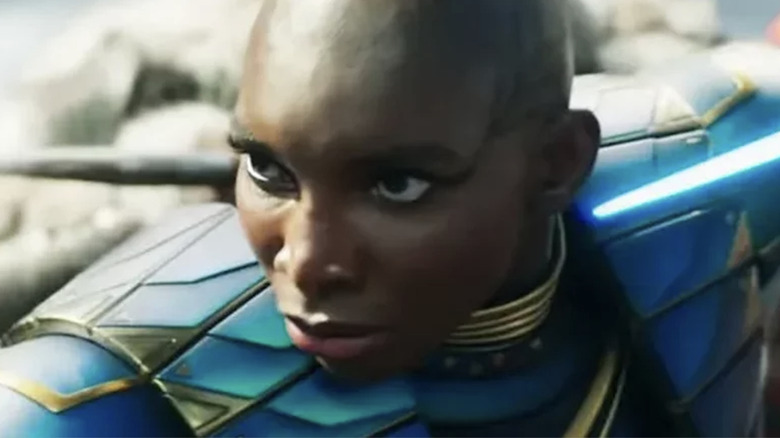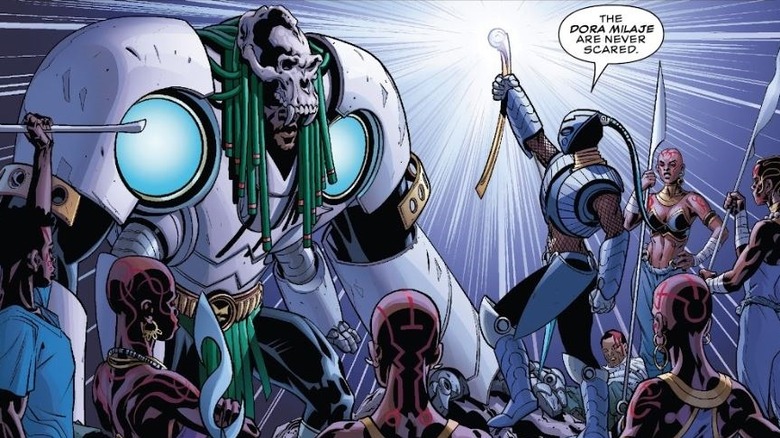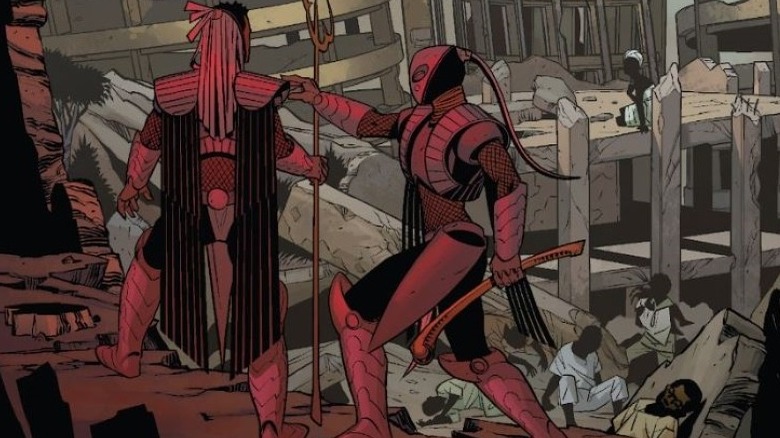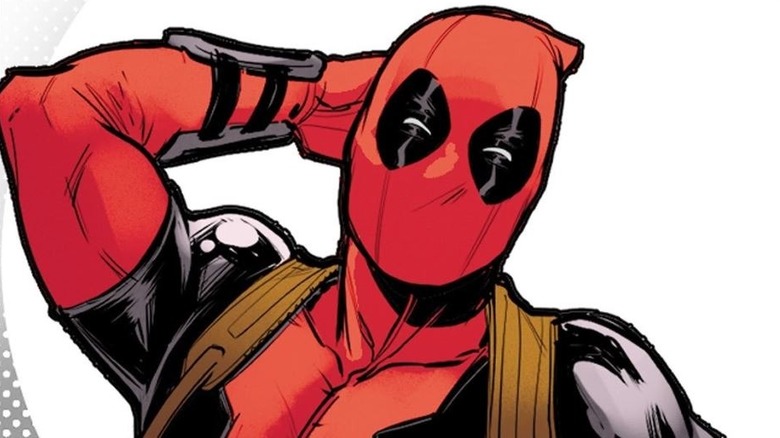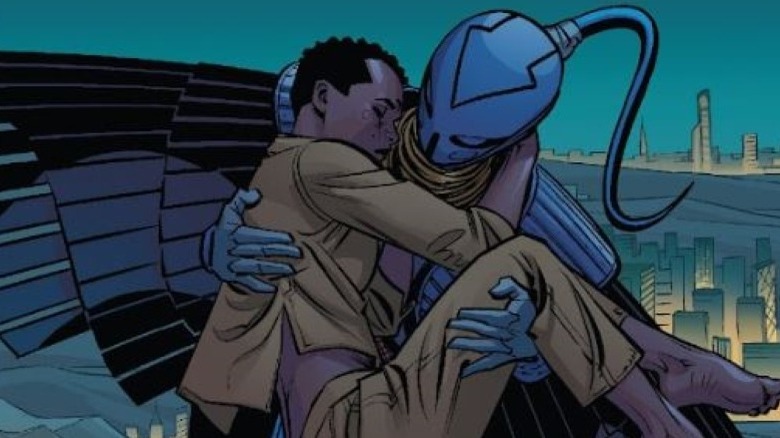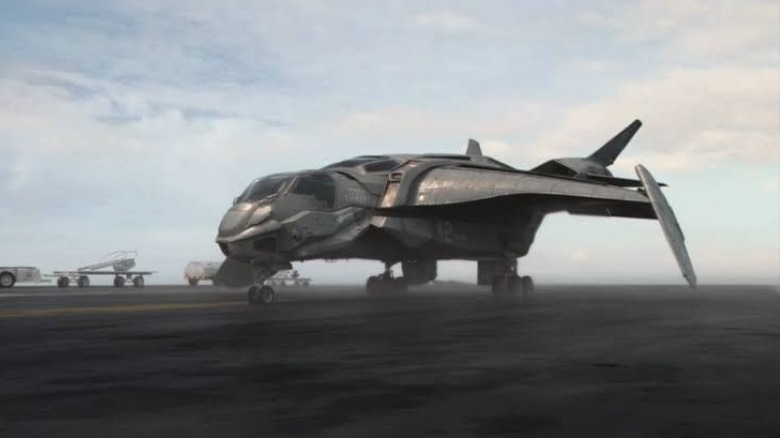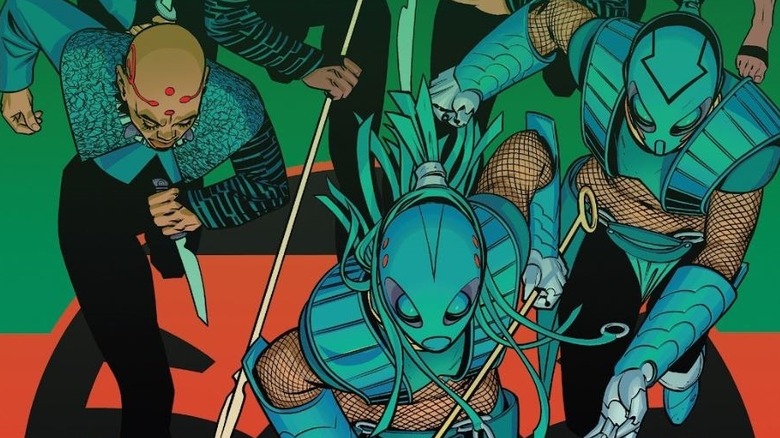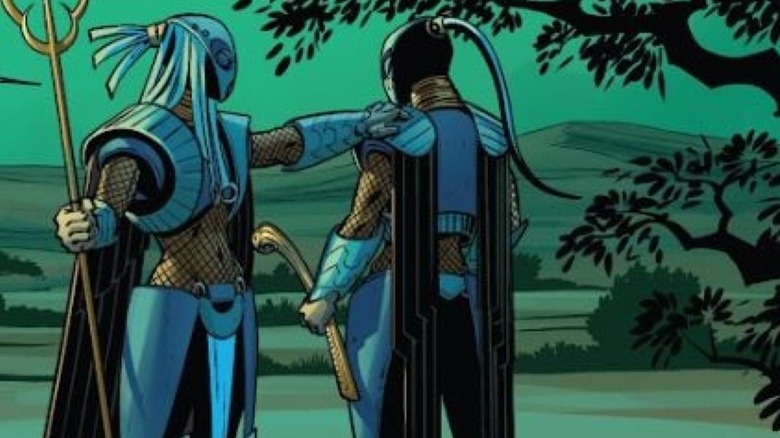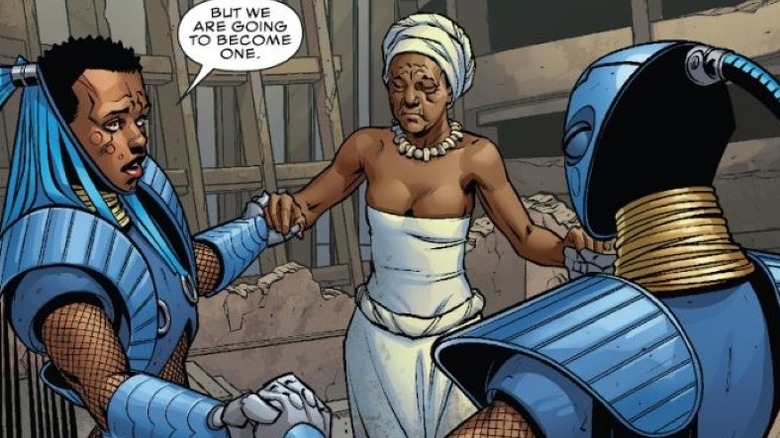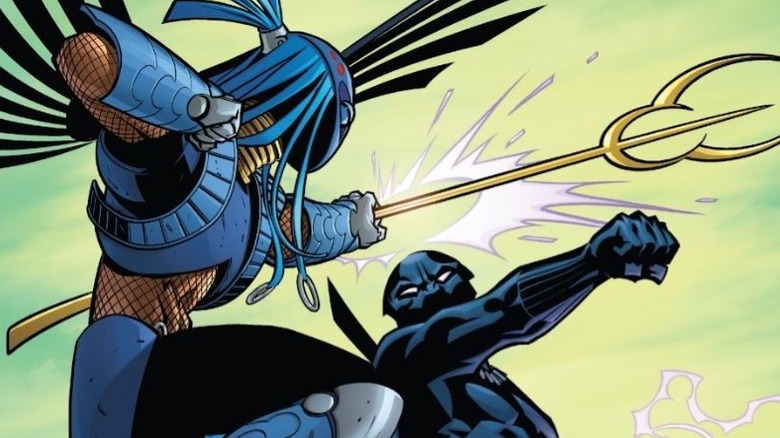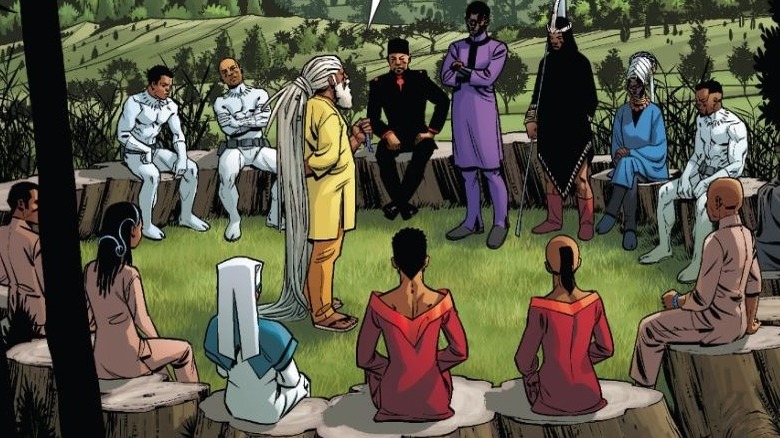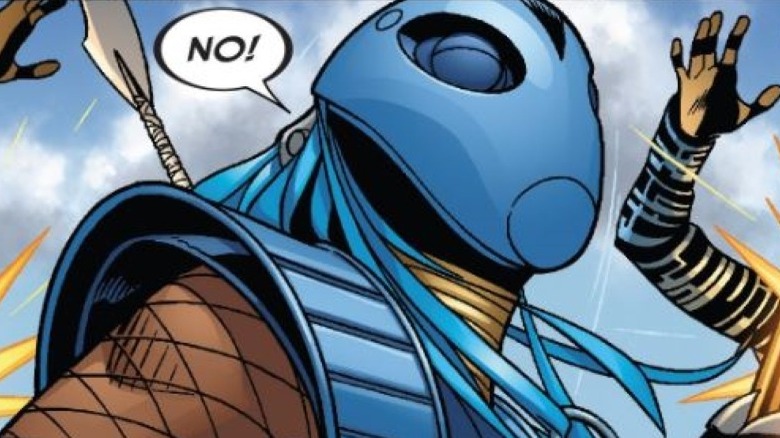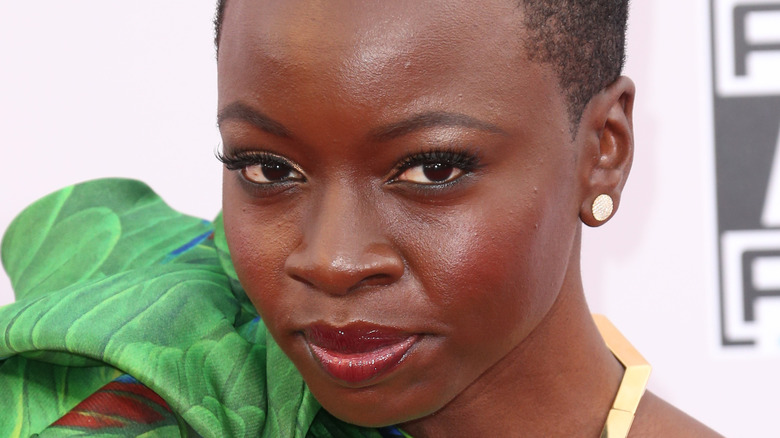12 Midnight Angels Facts To Prepare Marvel Fans For Okoye's MCU Spinoff Series
A critical success, as well as a box-office hit, "Black Panther: Wakanda Forever" is another triumph for the seemingly unstoppable Marvel Cinematic Universe. Bringing back director Ryan Coogler to craft a sequel to his Wakanda-building "Black Panther" movie paid off, as he once again has harnessed a deep knowledge and understanding of Black Panther history and the comic book mythology around Wakanda. In this sequel, the fictional African nation is center stage, as elements of its 56-year literary history are sprinkled throughout.
One of the more thrilling reveals in the film is the development of a pair of new high-tech outfits, handcrafted by Shuri. Making a splash in the climax, the armored suits gain their title: the "Midnight Angels." These blue uniforms are pulled from the panels of "Black Panther" comic books, and are quite loyal to what fans have seen on the page — and those who recognize them will be thrilled, knowing the full history of the upgraded Dora Milaje armor.
While the Midnight Angels have made a significant impact on the literary Wakanda, their appearance has mostly been limited to books featuring Black Panther's name. If you were previously unaware of the lore around the Midnight Angels — and excited about the potential of an upcoming Okoye spinoff series — read on for a briefing about these distinctive, relatively new Marvel Universe heroes.
Who are the Midnight Angels?
The Midnight Angels are best described as a subgroup of the Dora Milaje. Just as the US Army has their Green Berets and the Navy has its SEALs, they are the fictional equivalent of an elite special forces team.
As audiences have learned, the Dora Milaje are the all-female elite warrior force tasked with serving as personal bodyguards to the Wakandan Royal family, more specifically, the Black Panther. This militant group is made up of only one recruit from each tribe across Wakanda, and only the best of them can be selected for the Midnight Angels. The elite-of-the-elite Angels have most commonly been portrayed with just two members — yet, their membership has included as many as five at one time.
In the film "Black Panther: Wakanda Forever," the two Midnight Angel suits available were worn by Okoye (Danai Gurira) and Aneka (Michaela Coel). However, in comic books, Okoye has never been a member of the subgroup. Instead, the Angels are co-led by romantic partners, Aneka and Ayo (Florence Kasumba), occasionally joined by some of the best warriors the Dora Milaje has to offer. Appointed by King T'Challa, the Midnight Angels strike force was originally assembled for a near-impossible mission.
Formation for the Doom War
The formation of the Midnight Angels was essential during one of Wakanda's most desperate hours. In the pages of Marvel Comics circa 2010, King T'Challa and his people faced what was arguably their biggest threat of all time, Doctor Doom. Taking place during the miniseries "Doomwar," the Latverian monarch, Doom, devised a plan to steal Wakanda's greatest resource, vibranium. After funding a revolutionary political group to overthrow the Wakandan royal family, Doom was able to capture their entire reserve of the precious metal that grants the fictional African country its technological advancement.
In the aftermath, Wakanda was left in shambles. Doom, in the wake of his transgression, used the precious metal to enhance his suit and powers, as well as his army of Doombots.
Desperate, Shuri and T'Challa were forced to seek aid from allies, such as the X-Men and Fantastic Four. Together, the superhero alliance developed a plan to attack Doom head-on in his home state of Latveria. However, the battle was a front for the king's true plans. Secretly, T'Challa assembled a strike force of elite enforcers, dubbed the Midnight Angels, to accomplish the impossible by assassinating Doctor Doom. This original line-up of the Angels included Aneka and Ayo, along with three unnamed members of the Dora Milaje; these elite professionals would be joined by one of the most unpredictable, unprofessional characters in comic books.
An unlikely ally
When it came to contracting someone to kill the nefarious Doctor Doom, Black Panther had his pick of the litter — nearly anyone on the righteous side of the Marvel Universe. Understandably, T'Challa made a decision that showcases how serious he was about the assassination. Instead of assigning a hero from the X-Men or Fantastic Four, Black Panther went with the most dangerous man he could think of, the infamous "Merc with a Mouth," Deadpool.
The Midnight Angels collaborated effectively with the traditionally difficult-to-work-with Wade Wilson, cutting off Doom's connection to vibranium and coming close to killing the villain. Despite their best efforts, including making sure they had no vibranium on their person, Doctor Doom got the better of the group. However, Deadpool had another trick up his sleeve, connecting a direct call between the Latverian overlord and the female Black Panther, Shuri.
Ultimately, Black Panther was forced to do the unthinkable, de-powering all the vibranium in the world, rendering it useless.
The Midnight Angel armor
The most significant defining feature of the Midnight Angels is their upgrade of the traditional (somewhat vulnerable) Dora Milaje uniforms for something more aggressive, intimidating and protective. This specially-designed armor for the Midnight Angels was, surprisingly, not introduced during the original incarnation of the strike force. Rather, the suits first appeared some six years later, in "Black Panther" Vol. 6 issue #1.
Seemingly taken straight off the comic book page, the design of the Midnight Angels in "Black Panther: Wakanda Forever" is impressively faithful. The color scheme of blue and gold is intact from the panels of the original design by writer Ta-Nehisi Coates and artist Brian Stelfreeze. There are some minor variations (the comic design requires extendable wings to initiate flight, the movie's armor acts as a one-piece outfit covering the whole body while the comics depict separate pieces with mesh cloth filling the gaps), but the solid masks and shoulder coverings are impressively accurate to their source material.
They have their own jet
One interesting staple of the Midnight Angels' arsenal absent from their cinematic debut is their specialized Quinjet, Dagger. In the group's comic debut, during their attack on Doctor Doom's Latverian castle, they were given the stealth jet as a part of their secretive strike. The omission of the plane in the "Wakanda Forever" makes sense, considering the origin story differs from its source material. However, MCU audiences are no strangers to the high-tech quinjet, so the Midnight Angels may receive its airship in future iterations.
Quinjets are a regular staple in the comic book and cinematic Marvel universes. Often utilized by The Avengers or SHIELD, these powerful airplanes are the transportation mode of choice for nearly every superhero team that needs to get somewhere quickly. In the MCU, Quinjets first appeared in "The Avengers" as standard equipment of SHIELD. Fans will also recognize the space-capable ship for delivering Hulk to Sakaar, where he would later destroy it during the events of "Thor: Ragnorak."
Rogues of Wakanda
To fully understand the comic version of the Midnight Angels, one must take a deep dive into one particular title, "Black Panther" Vol.6 — in fact, the squad rarely appears outside of this run. Although short-lived, the 18-issue series is considered a gem in the ongoing lore and mythology around Wakanda and its heroes. This 2016 volume was crafted by Ta-Nehisi Coates, a political journalist and author whose articles around racial culture earned him national recognition. His celebrated arrival at Marvel Comics on a new "Black Panther" series yielded the best-selling title.
The Coates vision of the "Black Panther" storyline side-stepped the king's traditional depiction as an unchallenged Wakandan monarch, instead portraying a citizenry who had grown increasingly disenchanted with its leader. The absence of Queen Shuri and the development of an insurgent political group, The People, had Wakanda facing internal turmoil in the opening panels of the series' first issue. Subsequently, Aneka and Ayo find themselves at the center of this unstable political climate, ultimately becoming enemies of the throne and forming their own faction of rebels. Subsequently, the Midnight Angels help reshape the African nation, a story told throughout the moving, 12-part storyline "A Nation Under Our Feet."
Separation from the Dora Milaje
"Black Panther" Vol. 6 issue #1 was centered on Aneka, on trial for the crime of murder. As a member of the Dora Milaje, the powerful warrior came upon an unsettling issue in a small Wakandan tribe. The chieftain of this group was taking advantage of the defenseless girls of the village, and her answer was to throw a spear through the man's head. Unfortunately, the Queen Mother of Wakanda, Ramonda, did not take well to answering violence with more violence — and sentenced Aneka to death.
But Aneka would not spend much time imprisoned, nor would she face execution, as that very same evening Ayo arrived to break her romantic partner free. In essence committing herself to the same fate as her lover, Ayo stole the two existing prototypes of the Midnight Angel armor. Agreeing to separate from the Dora Milaje, the women chose to stop following the orders of one man. In their new outfits, they began to live as renegades, taking out the unconscionable criminals of Wakanda and beginning a new life with their own set of rules.
They started their own tribe
As vigilantes, the Midnight Angels became icons of revolution in Wakanda. "No one man" became the rallying cry for an uprising led by the two women, with the implication clear: Black Panther had too much control.
The Angels' biggest concern focused around T'Challa's perceived preoccupation with American issues, even as violence and atrocities plague Wakanda and go largely ignored. Ultimately, the women discover that beating up unscrupulous chieftains and murderous tribes is not enough to make a difference; unable to be everywhere at once in their sprawling countryside, many of their accomplishments are short-lived, as freed villages are quickly retaken, liberated women quickly recaptured.
By "Black Panther" Vol. 6 issue #4, the Midnight Angels had begun building their own army, sourced from the people that they have helped. Needing a base of operations, the women overtook the Jabari lands formerly reigned over by M'Baku. Developing a new tribe, many of the Jabari and members of the Dora Milaje joined Aneka and Ayo in their new tribe. Quickly, the Midnight Angels navigated their way from discarded renegades to heads of a new revolution in Wakanda. And it didn't take long for other revolutionaries to come knocking on their door.
War with the Royal family
During the rise of the Midnight Angels, another revolutionary group were similarly causing trouble for the existing governing body of Wakanda. They were called "The People" and headed by the shaman Tetu, fighting for a better life in Wakanda.
With Tetu's alliance to the neighboring country of Niganda and other destructive tactics, the Midnight Angels were wary about blending their causes. However, as King T'Challa became increasingly unhinged by the terrorist attacks and talks of revolution, the Black Panther began making more unethical approaches to his enforcement.
As a method of quelling the developing revolution in the Jabari Lands, T'Challa sent a squadron to disperse the growing number of people joining the Midnight Angels cause. In issue #6 of "Black Panther" Vol. 6, Aneka and Ayo's new tribe was nearly defeated, but saved by Tetu and his powerful ally Zenzi. Thankful and desperate, the Angels agreed to join The People in a planned attack on Wakanda's Golden City, Birnin Zana. However, a newly-revived Shuri gracefully convinced them to stand aside. A good thing, as The People would be swiftly defeated in the battle.
A democratic revolution
While The People's forced revolution ultimately failed to manifest, the Midnight Angels decided to take a more passive approach. After the war in the Golden City, negotiations took place involving the governing bodies of Wakanda, the royal family, and the new leaders of the Jabari lands.
Issue #12 of "Black Panther" Vol. 6, the final installment in the "A Nation Under Our Feet" storyline, sees Aneka and Ayo forgiven for their crimes. After some negotiations, T'Challa concedes, turning Wakanda into a democratic republic. His station as king remains only as a figurehead.
So, while the Midnight Angels play an important role in the "Wakanda Forever" film, their place in the comic books is much more potent. They fought against the grain and envisioned a better Wakanda. While some of their methods were unnecessary, and they went about it in a roundabout way, Aneka and Ayo were right. They helped the thriving nation of Wakanda become a better place for all its people. Unfortunately, later imprints of "Black Panther" have gone without the Midnight Angels or their powerful armor. Yet, their arrival in the MCU could see them adapted in future comic books, as the two industries often bounce ideas and themes back and forth.
Potential impact on the MCU
As the Midnight Angels break into the MCU, fans have begun speculating about potential implications. Most significantly, there is a chance the Angels origin story could come into play on the big screen, which would entail not only major repercussions for Wakanda, but also the eagerly-anticipated introduction of Doctor Doom in the MCU. The timing would fall into line, after all, as primary Doom foe the Fantastic Four are on their way.
Similar to how Namor made his debut in "Wakanda Forever," could Doom be the next longtime Marvel icon to infiltrate Wakanda? A storyline inspired by the "Doom War" could also bring Okoye into the company of Ryan Reynold's Deadpool — an onscreen duo that would surely create some dynamic contrast, and a partnership that could tick off another item on the MCU's "to-do" list, bringing Deadpool into the picture.
Alternatively, the comic mythology around the Midnight Angels is complex, perhaps too much so to effectively detail on screen, particularly if you're going to start throwing other MCU storylines into a film. An adaptation of Ta-Nehisi Coates' story of Wakanda's revolution could be a strong framework for the third (and perhaps final) installment of a "Black Panther" trilogy. With Okoye no longer a member of the Dora Milaje, and empowered by her new Shuri-designed outfit, the fan-favorite character could help make significant changes in Wakanda in future installments. Meanwhile, Aneka and Ayo's comic book relationship is still yet to be fleshed out, following a subtle hint of connection in the latest feature.
Will there be a Midnight Angel series?
Thankfully, audiences will not have to wait long for answers surrounding the Midnight Angels' impact in the MCU. It was confirmed in Spring 2021 that when Danai Gurira signed on to reprise her portrayal of Okoye in "Black Panther: Wakanda Forever," she would also star in her own Disney+ spin-off series. Much of this upcoming series has been kept under wraps, leading to much speculation of the potential premise.
Perhaps, much of the hush-hush surrounding Okoye's television series was concealing her character's Midnight Angel status.
Now that audiences are aware of where Danai Gurira's placement in Wakanda lies, it seems realistic that a new series could explore her regrouping after being dismissed from the Dora Milaje. Additionally, the basis of the Midnight Angels storyline from the comic books would equally make for a potentially groundbreaking series that recalibrates the leadership in Wakanda. It would not be surprising if an announcement about the upcoming series is imminent; it also wouldn't shock anyone if it were titled "The Midnight Angels."
